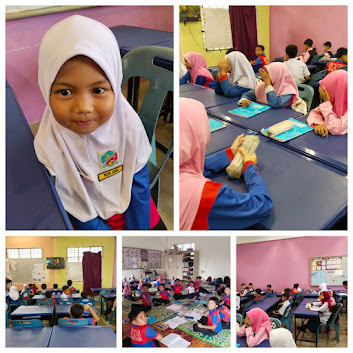ENGLISH CORNER - The Show and Talk activity, as introduced in the Highly Immersive Programme HIPMaX Toolkit developed by ELTC, is designed to foster confidence, fluency, and creativity in English among primary school pupils. At SK Gual To'Deh, a school located near the Thai border in Kelantan, this activity has been effectively adapted to suit pupils’ cultural background and English proficiency levels.
In this implementation, pupils engaged in the activity by bringing pictures, toys, or models of animals, and talked about them in simple English. This task encouraged them to speak naturally and confidently about a topic they are familiar with — animals. See the video here.
Objectives of the Show and Talk Activity
Based on the HIPMaX guide, the primary objectives of Show and Talk are as follows:
-
To develop pupils' confidence in using English orally in a supportive, non-threatening environment.
-
To improve pupils’ fluency and accuracy by encouraging spontaneous speech using familiar topics and vocabulary.
-
To stimulate critical and creative thinking, especially when answering teacher’s prompts like:
-
“Why do you like this animal?”
-
“What does it eat?”
-
“Where can it be found?”
-
-
To strengthen interpersonal communication through peer sharing and active listening during presentations.
Implementation at SK Gual To'Deh
Considering the location and socio-linguistic context of SK Gual To'Deh, where many pupils speak Malay, Thai, or Kelantanese dialects as their first language, the Show and Talk activity was tailored to accommodate their language readiness:
-
Pupils were placed in small groups (5–8 students per group) to build comfort.
-
Bilingual scaffolding was used at the beginning (e.g., teacher modeled in BM + English) before moving into full English use.
-
Teachers introduced animal-related vocabulary in earlier lessons to build their background knowledge and reduce language anxiety.
-
Pupils were given visual aids, such as animal flashcards, drawings, or even plush toys, to support their talk.
Theme: Animals
Each pupil presents their chosen animal and then discusses the following questions with their group:
-
Can you describe your animal in detail (appearance, size, colour)?
Example: “My animal is a large mammal. It has thick grey skin, big ears, and a long trunk.” -
Where is this animal usually found? Is it native to Malaysia or other countries?
Example: “This animal is usually found in the rainforest in Southeast Asia. It is native to Malaysia.” -
What is its diet? Is it a carnivore, herbivore, or omnivore?
Example: “It is a herbivore. It eats grass, leaves, and fruits.” -
How does this animal behave in the wild or in captivity?
Example: “In the wild, it travels in herds and protects its young. In captivity, it is usually calm and friendly.” -
Why did you choose this animal to talk about?
Example: “I chose this animal because I think it’s unique and intelligent. I’ve always wanted to see one up close.” -
What makes your animal special or interesting?
Example: “It can remember people and places, which shows it has a good memory.” -
What threats does this animal face in the wild (e.g., hunting, pollution)?
Example: “This animal is endangered because of illegal poaching and deforestation.” -
Do you think this animal should be kept in a zoo or in the wild? Why?
Example: “I think it should live in the wild, but if it is endangered, zoos can help protect it.” -
Have you ever seen this animal in real life? If yes, where? If not, where would you like to see it?
Example: “Yes, I saw it at the Kuala Lumpur Zoo.” / “I’d love to see it in the jungle of Taman Negara.” -
If you could be this animal for a day, what would you do?
Example: “If I were a tiger, I would run through the forest and hunt for food.”
Impact on Pupils
The results were encouraging:
-
Pupils became more confident in speaking English, especially those in the CEFR Pre-A1, A1 and B1 levels.
-
Some students from bilingual households (Thai–Malay) began to use English spontaneously in class activities.
-
The fun and engaging nature of the activity created a positive learning climate and reduced the fear of making mistakes.
Reflection and Recommendation
This activity aligns well with CEFR-aligned teaching, especially for young learners in rural and border areas. For future sessions, the following enhancements are suggested:
-
Introduce peer feedback rubrics to guide pupils in giving simple compliments or suggestions in English.
-
Record pupil presentations as a form of formative assessment and parental engagement (e.g., WhatsApp sharing).
-
Link the Show and Talk content to writing activities (e.g., a simple paragraph about “My Favourite Animal”) for integrated language development.










